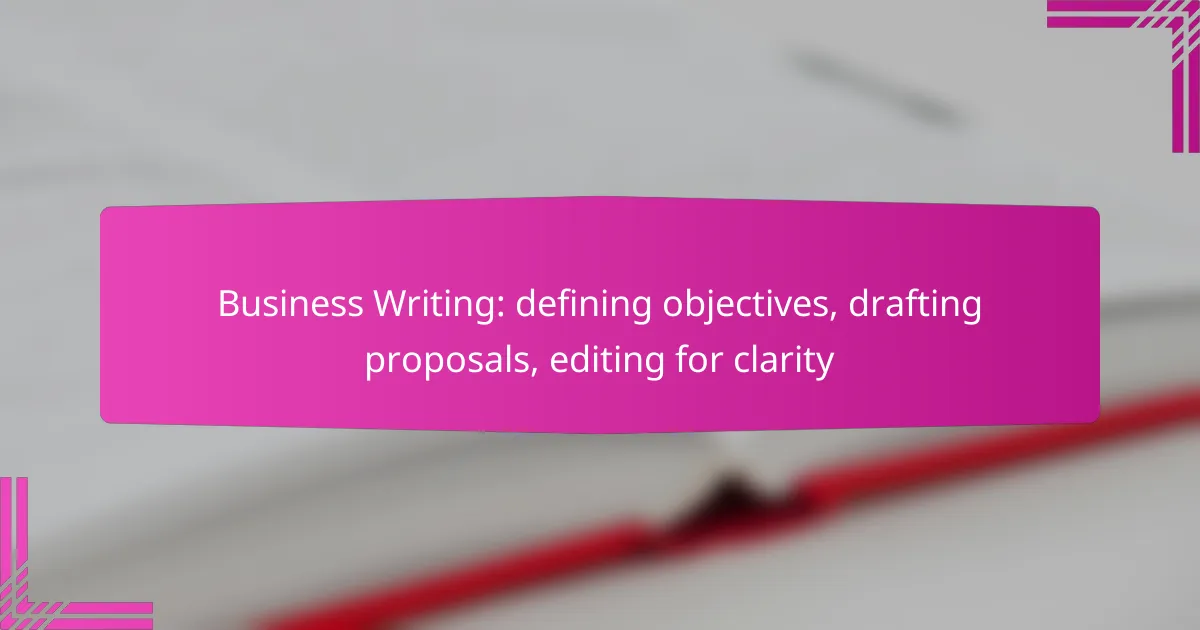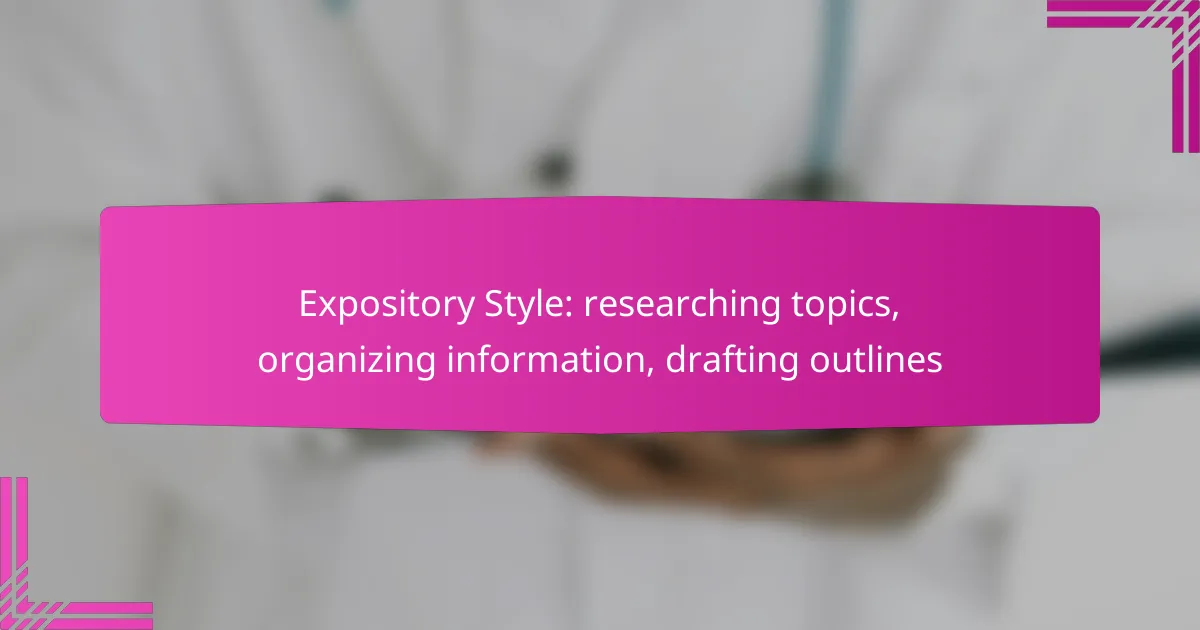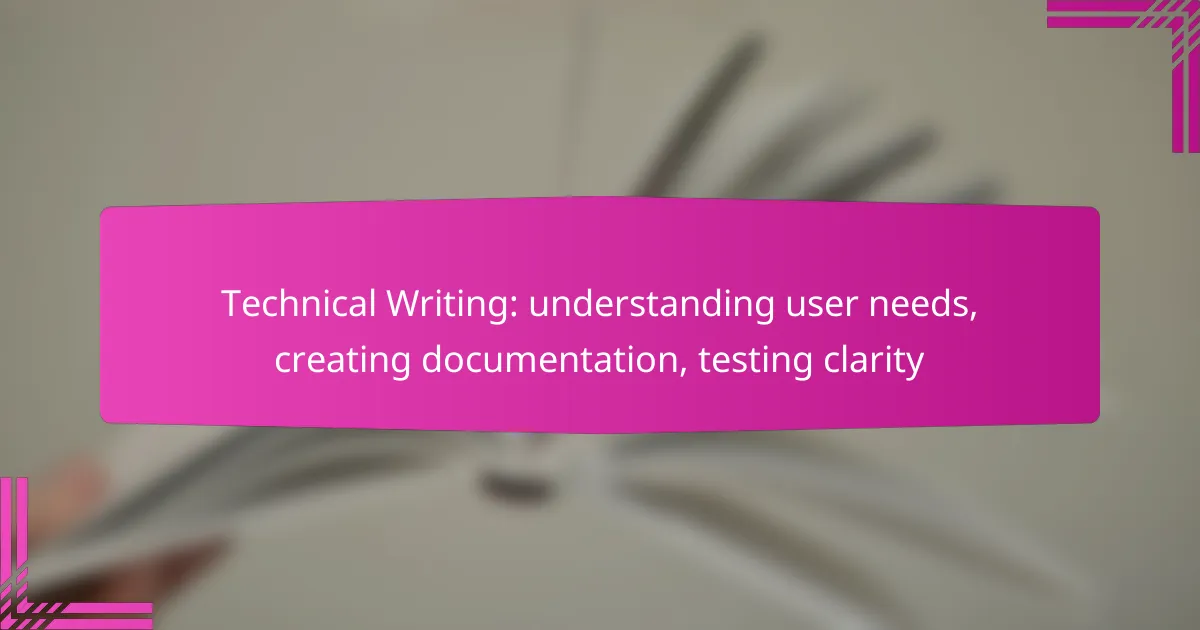In business writing, defining clear objectives is essential for guiding the writing process and ensuring alignment with broader organizational goals. Drafting effective proposals requires a structured approach that considers the audience and employs persuasive language to enhance acceptance. Finally, editing for clarity is crucial, as it involves simplifying language and organizing information logically to improve understanding.

How to define objectives in business writing?
Defining objectives in business writing involves clearly articulating specific goals that guide the writing process. These objectives should be measurable and aligned with broader business aims to ensure effectiveness and clarity.
SMART objectives framework
The SMART objectives framework is a widely used method for setting clear and achievable goals. SMART stands for Specific, Measurable, Achievable, Relevant, and Time-bound. For example, instead of stating “increase sales,” a SMART objective would be “increase sales by 15% in the next quarter.”
When applying the SMART criteria, ensure that each objective is clearly defined and includes a timeline for completion. This approach helps maintain focus and accountability throughout the writing process.
Aligning objectives with company goals
Aligning your writing objectives with company goals is crucial for ensuring that your efforts contribute to the overall success of the organization. Start by reviewing the company’s mission and strategic priorities to identify how your objectives can support these aims.
For instance, if a company aims to enhance customer satisfaction, a relevant writing objective might be to create a comprehensive customer service guide within two months. This alignment fosters coherence and maximizes the impact of your writing.
Measuring success of objectives
Measuring the success of your objectives involves tracking progress and outcomes against the defined criteria. Utilize key performance indicators (KPIs) relevant to your objectives, such as sales figures, customer feedback scores, or engagement metrics.
Regularly review these metrics to assess whether the objectives are being met and adjust your strategies accordingly. For example, if the goal was to improve customer satisfaction ratings by 20% within six months, analyze customer surveys to determine if the target is on track or if further adjustments are needed.

What are effective strategies for drafting proposals?
Effective strategies for drafting proposals include clear organization, understanding the audience, and using persuasive language. A well-structured proposal that addresses the needs of the recipient increases the chances of acceptance.
Structure of a winning proposal
A winning proposal typically follows a clear structure that includes an introduction, problem statement, proposed solution, budget, and conclusion. Each section should flow logically, guiding the reader through the argument.
Start with an executive summary that outlines the key points, followed by a detailed description of the problem and how your solution addresses it. Use headings and bullet points to enhance readability and highlight important information.
Common proposal formats in Australia
In Australia, common proposal formats include business proposals, grant proposals, and project proposals. Each format may have specific requirements, but they generally share a focus on clarity and conciseness.
For instance, business proposals often include a cover letter, an overview of the company, and detailed project plans. Grant proposals typically require a budget breakdown and alignment with funding criteria, while project proposals emphasize timelines and deliverables.
Using persuasive language techniques
Persuasive language techniques are essential for making your proposal compelling. Use active voice, strong verbs, and positive language to convey confidence in your solution. Phrases like “proven results” or “successful outcomes” can enhance credibility.
Additionally, incorporating storytelling elements can engage the reader emotionally. Use case studies or testimonials to illustrate the effectiveness of your proposal. Avoid jargon and ensure that your language is accessible to all potential readers.
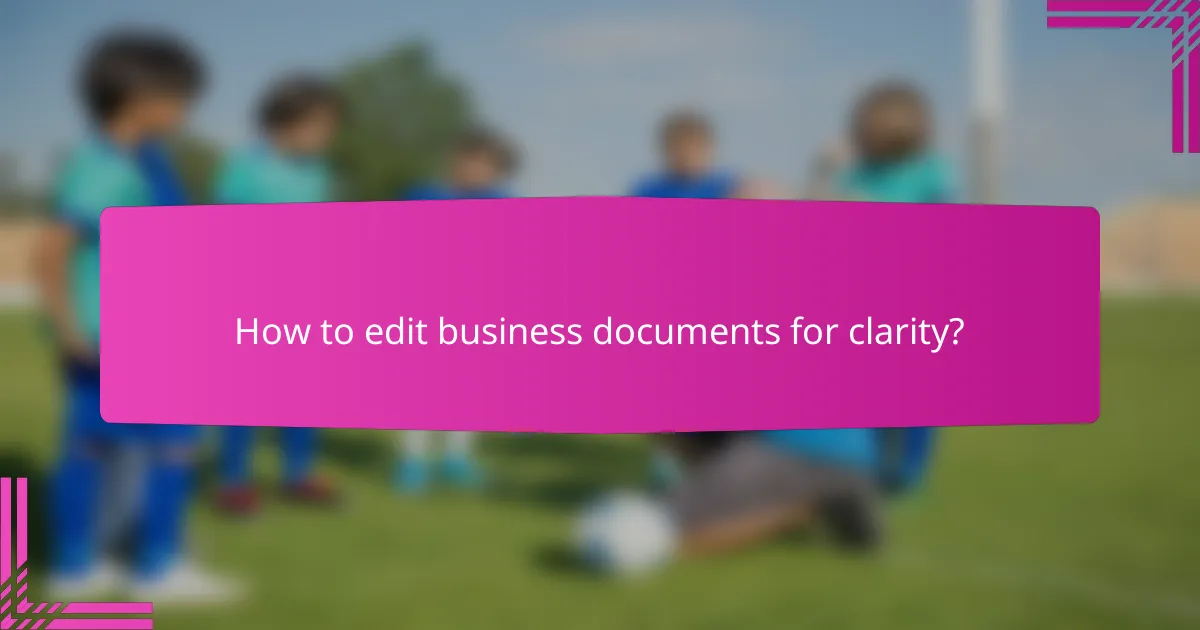
How to edit business documents for clarity?
Editing business documents for clarity involves reviewing content to ensure it is straightforward and easily understood. Focus on simplifying language, eliminating jargon, and structuring information logically to enhance comprehension.
Techniques for concise writing
Concise writing eliminates unnecessary words and focuses on the main message. Use short sentences and active voice to convey ideas clearly. For example, instead of saying “The report that was submitted by the team was well received,” say “The team’s report was well received.”
Another technique is to avoid filler phrases. Replace “due to the fact that” with “because.” Aim for clarity by choosing precise words that convey your point without ambiguity.
Tools for grammar and style checking
Utilizing grammar and style checking tools can significantly enhance document clarity. Tools like Grammarly and Hemingway App help identify grammatical errors, suggest style improvements, and highlight complex sentences. These tools are particularly useful for non-native English speakers or those unfamiliar with business writing conventions.
Consider integrating these tools into your writing process. They can provide real-time feedback and help maintain consistency in tone and style across documents.
Importance of peer reviews
Peer reviews are essential for improving clarity in business documents. Having colleagues review your work can uncover unclear sections and provide fresh perspectives on how to communicate ideas more effectively. Aim to gather feedback from individuals who understand the document’s purpose and audience.
Establish a structured review process where peers can provide specific comments. This collaborative approach not only enhances clarity but also fosters a culture of continuous improvement within your team.

What are the prerequisites for effective business writing?
Effective business writing requires a clear understanding of your audience and adherence to relevant industry standards. These prerequisites ensure that your message is tailored, relevant, and professional.
Understanding your audience
Knowing your audience is crucial for effective business writing. Tailor your language, tone, and content to meet their expectations and needs. For instance, a proposal aimed at executives may require a formal tone and concise information, while a communication to team members can be more casual and detailed.
Consider demographics, such as age, profession, and cultural background, as these factors influence how your message is received. Conducting a brief survey or gathering feedback can provide insights into what your audience values most.
Researching relevant industry standards
Familiarizing yourself with industry standards is essential for credibility in business writing. This includes understanding common terminologies, formatting styles, and regulatory requirements specific to your field. For example, financial proposals often adhere to strict guidelines set by regulatory bodies, which can vary by country.
Utilize resources such as industry publications, professional organizations, and online databases to gather accurate information. Staying updated on trends and best practices can enhance the quality of your writing and ensure compliance with any applicable regulations.
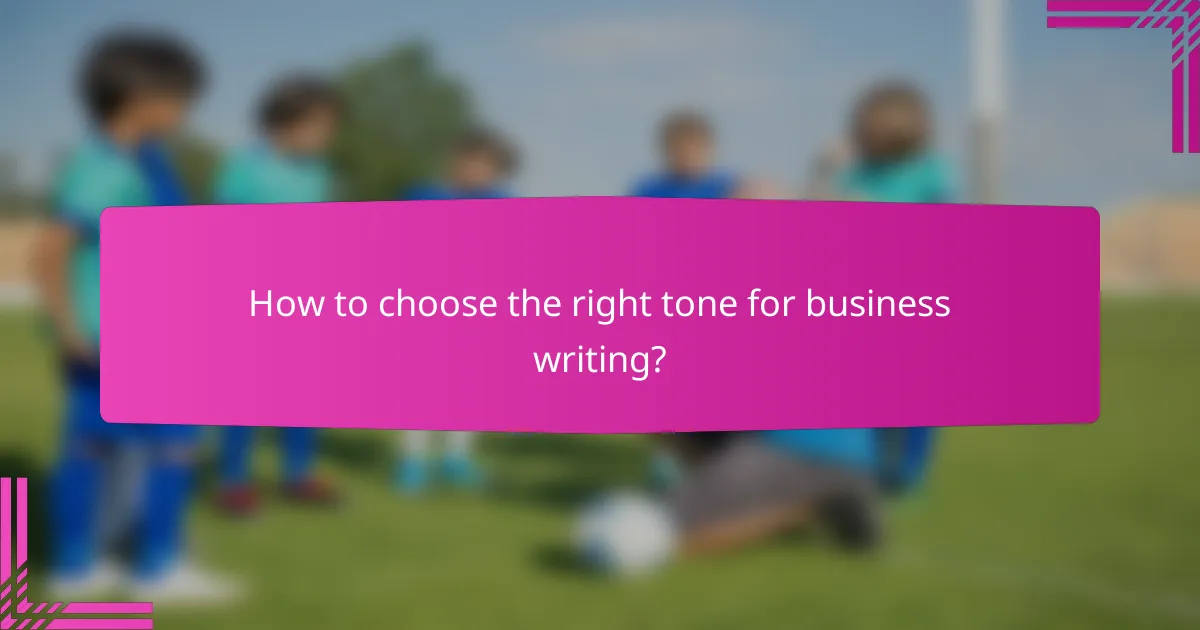
How to choose the right tone for business writing?
Choosing the right tone for business writing is essential for effective communication. The tone should align with the purpose of the document and the audience’s expectations, ensuring clarity and engagement.
Formal vs informal tone considerations
When deciding between a formal or informal tone, consider the context and audience. Formal writing is often used in contracts, reports, and official communications, where professionalism is paramount. Informal tone may be suitable for internal emails or casual updates, where a friendly approach can foster collaboration.
Use a formal tone when addressing clients, stakeholders, or in situations requiring authority. Conversely, an informal tone can be effective in team settings, where building rapport is beneficial. Always assess the potential impact of your tone on the message being conveyed.
Adapting tone for different audiences
Understanding your audience is crucial for adapting your tone appropriately. Different groups, such as executives, colleagues, or clients, may have varying expectations regarding formality and style. Tailoring your tone to fit these expectations can enhance receptiveness and comprehension.
For instance, when writing to executives, a concise and respectful tone is often preferred, focusing on key points and outcomes. In contrast, when communicating with peers, a more conversational tone can encourage open dialogue. Always consider the cultural context as well, as norms around formality can vary significantly across regions and industries.
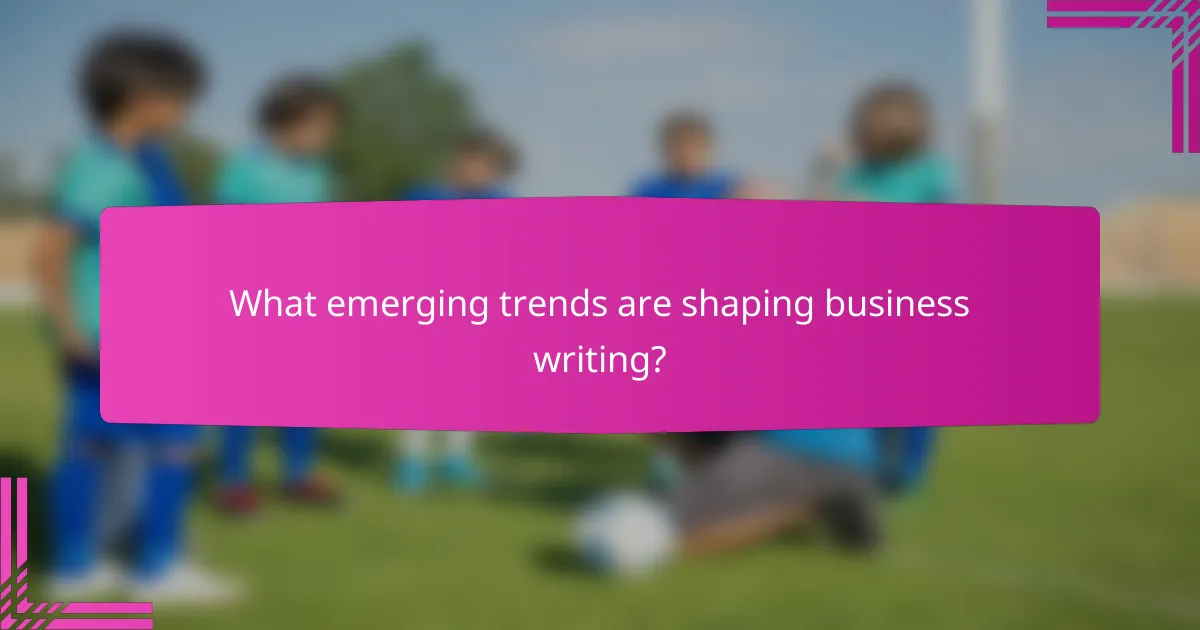
What emerging trends are shaping business writing?
Emerging trends in business writing are increasingly influenced by technology, particularly artificial intelligence, and a growing emphasis on clarity and conciseness. These trends are reshaping how professionals draft proposals, define objectives, and edit documents for better communication.
Impact of AI tools on writing
AI tools are revolutionizing business writing by enhancing efficiency and improving content quality. These tools can assist in drafting proposals, generating ideas, and even editing for clarity, allowing writers to focus on strategic thinking rather than repetitive tasks.
When utilizing AI tools, consider their strengths and limitations. While they can provide quick suggestions and grammar checks, they may not fully grasp the nuances of your specific audience or industry. It’s essential to review and refine AI-generated content to ensure it aligns with your objectives and maintains a human touch.
To effectively integrate AI into your writing process, start by identifying tasks that can be automated, such as initial drafts or formatting. However, avoid over-reliance on these tools; always prioritize your unique voice and insights to maintain authenticity in your business communications.
